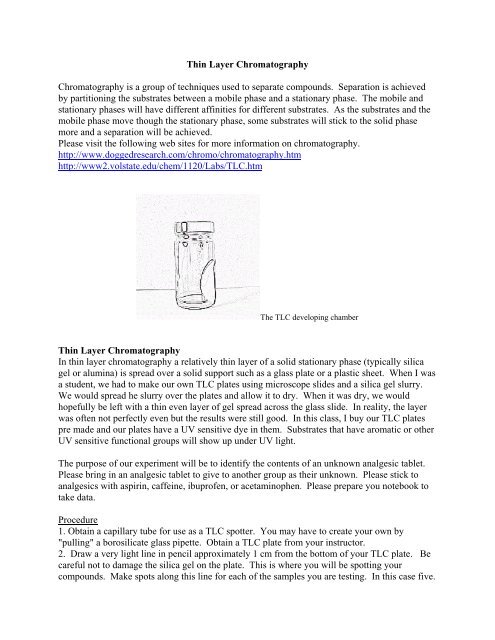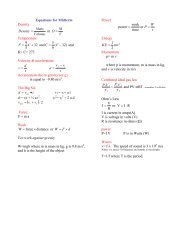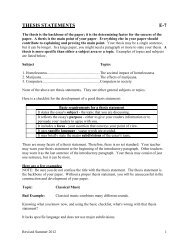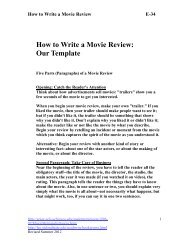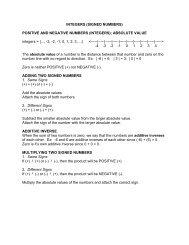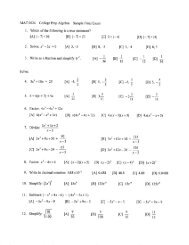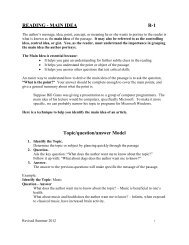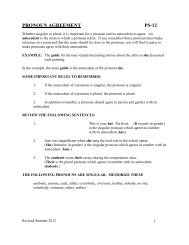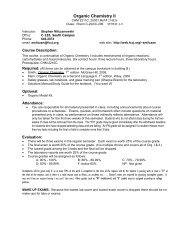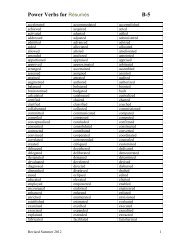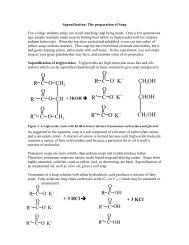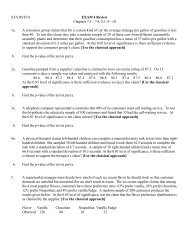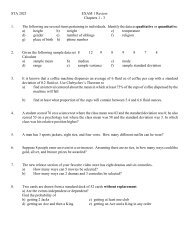Thin Layer Chromatography (TLC)(pdf)
Thin Layer Chromatography (TLC)(pdf)
Thin Layer Chromatography (TLC)(pdf)
You also want an ePaper? Increase the reach of your titles
YUMPU automatically turns print PDFs into web optimized ePapers that Google loves.
<strong>Thin</strong> <strong>Layer</strong> <strong>Chromatography</strong><strong>Chromatography</strong> is a group of techniques used to separate compounds. Separation is achievedby partitioning the substrates between a mobile phase and a stationary phase. The mobile andstationary phases will have different affinities for different substrates. As the substrates and themobile phase move though the stationary phase, some substrates will stick to the solid phasemore and a separation will be achieved.Please visit the following web sites for more information on chromatography.http://www.doggedresearch.com/chromo/chromatography.htmhttp://www2.volstate.edu/chem/1120/Labs/<strong>TLC</strong>.htmThe <strong>TLC</strong> developing chamber<strong>Thin</strong> <strong>Layer</strong> <strong>Chromatography</strong>In thin layer chromatography a relatively thin layer of a solid stationary phase (typically silicagel or alumina) is spread over a solid support such as a glass plate or a plastic sheet. When I wasa student, we had to make our own <strong>TLC</strong> plates using microscope slides and a silica gel slurry.We would spread he slurry over the plates and allow it to dry. When it was dry, we wouldhopefully be left with a thin even layer of gel spread across the glass slide. In reality, the layerwas often not perfectly even but the results were still good. In this class, I buy our <strong>TLC</strong> platespre made and our plates have a UV sensitive dye in them. Substrates that have aromatic or otherUV sensitive functional groups will show up under UV light.The purpose of our experiment will be to identify the contents of an unknown analgesic tablet.Please bring in an analgesic tablet to give to another group as their unknown. Please stick toanalgesics with aspirin, caffeine, ibuprofen, or acetaminophen. Please prepare you notebook totake data.Procedure1. Obtain a capillary tube for use as a <strong>TLC</strong> spotter. You may have to create your own by"pulling" a borosilicate glass pipette. Obtain a <strong>TLC</strong> plate from your instructor.2. Draw a very light line in pencil approximately 1 cm from the bottom of your <strong>TLC</strong> plate. Becareful not to damage the silica gel on the plate. This is where you will be spotting yourcompounds. Make spots along this line for each of the samples you are testing. In this case five.
3. Dissolve some of your mixture to be analyzed in a small test tube with a little solvent. (Youwant to choose a solvent which is relatively volatile and in which your compound is readilysoluble. Your <strong>TLC</strong> solvent can be a good choice.) Dip your <strong>TLC</strong> spotter into the solution andallow capillary action to draw some of the solution into it. Remove any large drops of solutionhanging from the edge and quickly touch the spotter to the <strong>TLC</strong> plate. The idea is to create avery small spot. In order to get the correct amount of material, I often apply material to the sameplace more than once. I dry the first spot by blowing gently and then spot again. The number oftimes you have to spot depends on the concentration of the sample, the type of <strong>TLC</strong> plate, thediameter of the spotter and probably a whole host of other things. I usually spot three times as ageneral rule.4. Setup your developing chamber by adding your developing solvent (In this case, 95% Ethylacetate: 5% acetic acid) to a depth just below 1 cm (approximately 3/4 of a cm). The filter paperon the side of the chamber helps keep the atmosphere on the chamber saturated with the solventand decreases the effects of evaporation.5. Put your <strong>TLC</strong> plate in the developing chamber with the top not touching the filter paper onthe side. Let the solvent rise to the within a centimeter of the top of the plate. Do not let thesolvent front reach the top of the plate.Remove the <strong>TLC</strong> plate from the chamber and mark the solvent front with your pencil. Allowthe plate to dry. (Let the solvent evaporate)6. How can we see the spots? In this case we are using a UV dye in the silica gel. The aromaticgroups in the painkillers will absorb the UV and so in the light box we should be able to see thespots. Take your plates to the light box and mark the spots with a pencil.7. Measure the distance from the starting line to each spot. Measure the distance from thestarting line to the line where the solvent traveled. Calculate and record the Rf for all spots youobserved on the plate. Rf is the distance the spot traveled/distance the solvent traveled. Alwaysinclude Rf values in your lab report. Draw a picture in your notebook of the <strong>TLC</strong> plate with thespots.
In this sample chromatogram, The Rf for the first spot is the distance A divided by the distanceB. When measuring the spots, you measure to the center of the spot. If the spot is tailing, youmeasure to the center of the darkest area of the spot. If you spots are too large, you may have torepeat the TLV, spotting a lesser amount. In this sample, 5 is the unknown and clearly is amixture of compounds 2 & 3.Post lab questions:1) Arrange the following in order of increasing Rf in <strong>TLC</strong>? 3-pentanone, 3-pentanol,pentane.2) If all your Rfs were too large, what would you do to your solvent system to bring themdown?• What solvent(s) would you try next?3) What would happen if you spotted too much compound on your <strong>TLC</strong> plate?4) One of the compounds we are examining today has a chiral center.• Which one has a chiral center?• Identify it.Other ReadingA background on Analgesics:http://www.chemheritage.org/EducationalServices/pharm/asp/asp08.htmMode of Action:http://catsis.weber.edu/ewalker/Medicinal_Chemistry/topics/Analgesia_antiinflam/Analgesics_anti-inflamitory.htm


